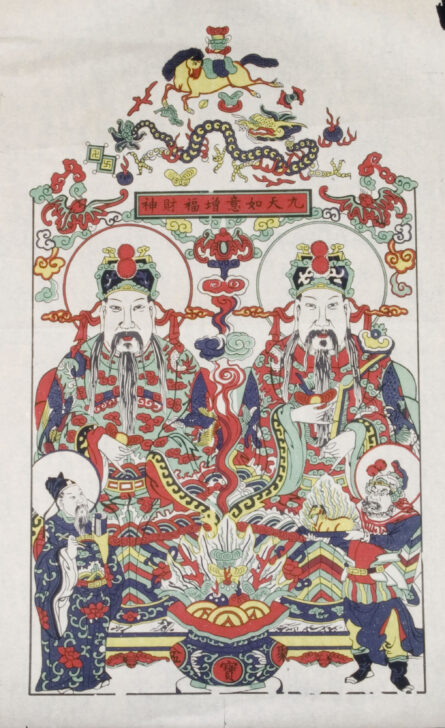Everything You Wish in the Nine Heavens: Gods of Wealth Increase Good Fortune
Chinese

Description
Taiwan
1960s
Color woodblock print on paper
Gift of Ellen and Richard Laing, 2006/2.49
Images such as this were among the prints used to bring good luck at the
beginning of the Chinese New Year. Because the paper images were burned in
ceremonies to release the gods for their “ascent” to heaven, they were replaced
each year. Here, two gods of wealth, wearing official robes and hats, sit side by
side. Both hold shoe-shaped ingots, and the one on the right also holds a scepter
called a ruyi (meaning “everything as you wish”). Before them is the never-empty
treasure basin, filled with coins and rarities such as gleaming round jewels,
branches of coral, and shining ingots. On the right, a foreigner, identifiable by his
curly beard, large eyes, and peaked hat, brings wealth in the form of a magic
horse on a tray; his counterpart on the left is an official holding a brush and a
scroll.
Symbols of wealth fill the picture. At the top is a dragon whose spine is
composed of coins and above him is a horse bearing a stack of shoe-shaped
ingots. The horse was the fastest mode of transportation in traditional China;
here he gallops to bring in the money. Although this print was purchased in
Taiwan, it is a copy of a composition from print shops in Yangliuqing, near Tianjin
in north China.
Subject Matter:
Two Gods of Wealth, wearing official robes and hats, sit side by side. The one on the right holds a shoe-shaped ingot and a scepter known as a “juyi” (everything as you wish). The god on the left holds only a shoe-shaped ingot. In front of them is the never-empty treasure basin filled with coins and rarities such as gleaming round jewels, branches of coral and shining ingots. On the right, a foreigner, identifiable by his curly beard, large eyes and peaked hat, brings in wealth in the form of a magic horse on a tray; his counter part on the left is an official holding a brush and a scroll. Symbols of wealth fill the picture. At the top is a sinuous dragon whose spine is composed of coins and above him is a horse bearing a stack of shoe-shaped ingots. The horse was the fastest mode of transportation in traditional China; here he gallops to bring in money.
Physical Description:
Two male figures wearing official robes and hats, sit side by side on thrones. The one on the right holds a shoe-shaped ingot and a scepter. The god on the left holds only a shoe-shaped ingot. In front of them is basin filled with coins and rarities such as jewels, branches of coral and shining ingots. On the right, a smaller male figure holds a horse on a tray while his counter part on the left holds a brush and a scroll. At the top is a sinuous dragon whose spine is composed of coins and above him is a horse bearing a stack of shoe-shaped ingots.
Usage Rights:
If you are interested in using an image for a publication, please visit https://umma.umich.edu/request-image/ for more information and to fill out the online Image Rights and Reproductions Request Form.